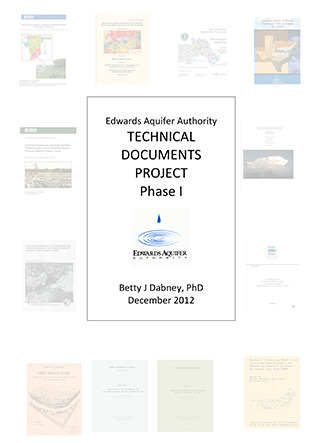Edwards Aquifer Authority Technical Documents Project Phase I

| Summary |
|
The Edwards Aquifer Authority (EAA) and its predecessor, the Edwards Underground Water District (EUWD), have developed an impressive body of scientific research and technical studies on the Aquifer over a period of many years. This Science & Research (S&R) Program has been necessary in order to develop an understanding of the geography, hydrogeology, capacity and behavior of the Aquifer and its associated springs and wells under a variety of climatic conditions and uses. As the major source of drinking water for two million people, the Edwards Aquifer is in an unusual position of being highly susceptible to natural and anthropogenic pollution as a result of extensive development over its Drainage and Recharge Zones. In the interest of transparency and to make these extensive data available to other researchers and to the general public alike, the EAA undertook this Technical Documents Project. The purposes of the Technical Documents Project were: To discover the legacy Technical and Scientific Reports of the Edwards Aquifer Authority that may exist in various places, either in hard copy or in electronic format; To digitize these documents, including thumbnail graphic images of the report covers, and convert them for Optical Character Recognition; To develop a new document classification system and reach consensus with the S&R Team on it; To put the documents on the EAA website in some kind of organized fashion, with Summaries, Descriptions, Keywords, Abstracts, and other identifiers in order to enhance the browsing and searching experience of the visitors to the website; and finally, To standardize the way the S&R Documents are entered, classified and organized on the EAA website and its server. At first it became apparent that the documents were spread out in many places. Many, but not all, were archived in the EAA Library. Some were in individual scientists’ offices and computers. Some were already on the EAA website but were in various places, were difficult to find, and were duplicated under different document titles. No one really knew how many documents there were. And as a result, it would be impossible to know when all the documents had been identified or how long this would take. Of the 383 documents found, 274 were selected for inclusion in Phase I, and 246 have been scanned or downloaded. The remainder are already on the EAA website, are of lower priority or have not been obtainable. More documents were discovered and added in Phase II from 2013-2014 and will be discussed in a separate report. |
Search for Documents
Advance Search
Explore EAA's Scientific Reports
- All Reports
- Modeling
- Hydrology and Hydrogeology
- History
- Groundwater Recharge, Recharge Zone
- Groundwater Movement
- Geomorphology and Caves
- Weather Modification
- Geology
- Water Use and Conservation
- Geochemistry
- Water Resources Planning and Management
- Floods and Drought
- Water Quality
- Climatology
- Surface Water / Groundwater Relationship
- Biology
- Springs, Groundwater Discharge
- Archaeology
- RZ Protection
- Aquifer Levels
- Remote Sensing
- Precipitation
- Overview Studies
